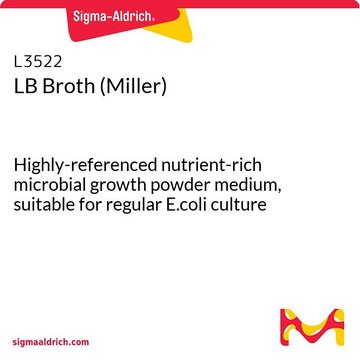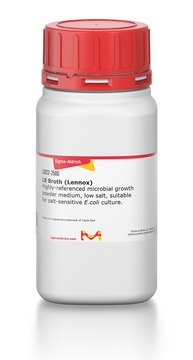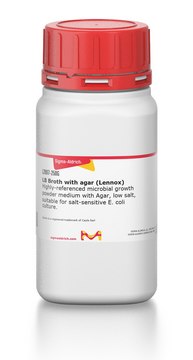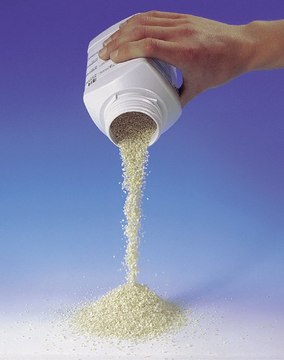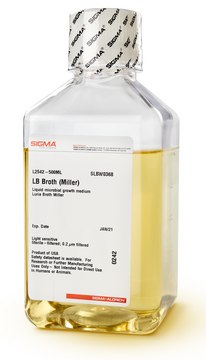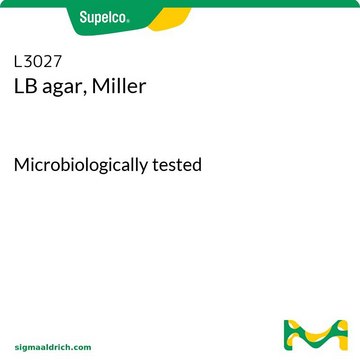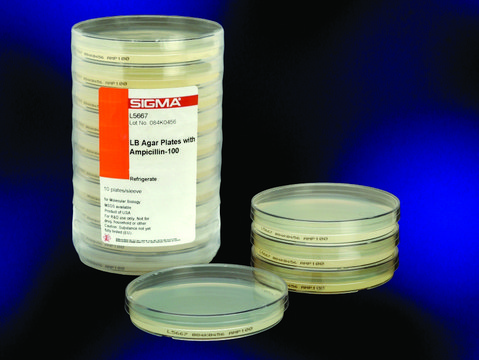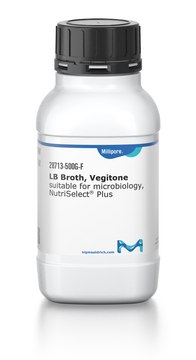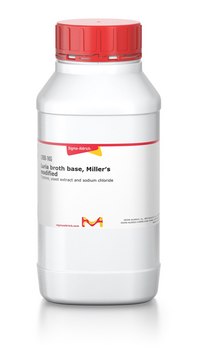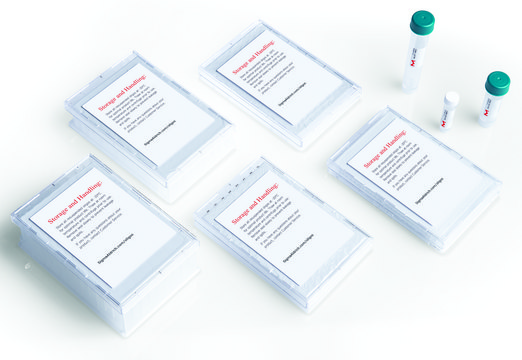L3147
LB Broth with agar (Miller)
Highly-referenced nutrient-rich microbial growth powder medium with Agar, suitable for regular E.coli culture.
Synonym(s):
Luria Agar, Luria Bertani agar, Miller’s LB agar, lysogeny broth agar
About This Item
Recommended Products
grade
for molecular biology
Quality Level
sterility
non-sterile
form
powder
composition
Agar, 15 g/L
NaCl, 10 g/L
Tryptone, 10 g/L
Yeast Extract, 5 g/L
technique(s)
microbiological culture: suitable
pH
6.8-7.2(4% solution)
application(s)
food and beverages
microbiology
storage temp.
room temp
suitability
nonselective for Escherichia coli
nonselective for coliforms
General description
Application
Features and Benefits
- Easy scale-up using larger package sizes
- A budget-friendly alternative to pre-poured plates
- Standard formulation
Preparation Note
2. Heat to boiling while stirring to dissolve.
3. Autoclave for 15 minutes at 121°C.
4. Cool to 50°C prior to dispensing into sterile petri dishes.
To prepare the medium of Luria and Burrows: Add 1 g glucose to medium and proceed with preparation instructions above.
To prepare the medium of Luria, Adams and Ting (also known as LC agar): Aseptically add 25 ml of sterile 0.1 M calcium chloride after autoclaving.
Reconstitution
related product
Storage Class Code
11 - Combustible Solids
WGK
WGK 3
Flash Point(F)
Not applicable
Flash Point(C)
Not applicable
Choose from one of the most recent versions:
Certificates of Analysis (COA)
Don't see the Right Version?
If you require a particular version, you can look up a specific certificate by the Lot or Batch number.
Already Own This Product?
Find documentation for the products that you have recently purchased in the Document Library.
Which document(s) contains shelf-life or expiration date information for a given product?
If available for a given product, the recommended re-test date or the expiration date can be found on the Certificate of Analysis.
How do I get lot-specific information or a Certificate of Analysis?
The lot specific COA document can be found by entering the lot number above under the "Documents" section.
How do I find price and availability?
There are several ways to find pricing and availability for our products. Once you log onto our website, you will find the price and availability displayed on the product detail page. You can contact any of our Customer Sales and Service offices to receive a quote. USA customers: 1-800-325-3010 or view local office numbers.
What is the Department of Transportation shipping information for this product?
Transportation information can be found in Section 14 of the product's (M)SDS.To access the shipping information for this material, use the link on the product detail page for the product.
What are the differences among the Luria, Lennox and Miller LB formulations?
LB, (originally termed lysogeny broth) was initially composed of tryptone, yeast extract, NaCl and glucose. Soon after, the glucose was omitted (Miller's version), and later the NaCl content lowered by half (Lennox's version). For some applications, even lower salt is required (Luria's low salt version).
What is the difference among the LB - Miller products?
LB - Miller is available in many types to suit your needs. The different product formats include powder and liquid form. The powder form is also available with agar for easy LB-agar plate preparation.L2542 (LB Miller liquid)L3522 (LB Miller powder)L3147 (LB Miller powder with agar)
Which bacterial culture medium is the best choice for my application?
Each of the broths will likely grow E. coli very well, but there are still general guidelines for choosing a broth when you are working without a protocol. Generally:LB - Miller and LB - Lennox are used for E. coli growth and maintanence, DNA plasmid production and protein production. The Lennox formulation has a lower salt content required for some salt-sensitive selection antibiotics.LB - Luria low salt is used for special applications where the E. coli growth or other constraints require the lowest possible salt content.Terrific Broth is used for higher yield protein production and high yield DNA plasmid production, because of the faster growth of the E. coli in this medium.SOB is used for protein production, DNA plasmid production and the generation of high-efficiency competent cells.SOC is used for initial growth of competent cells and the transformation procedure.
Will adding magnesium to the culture medium increase cell density?
In microbial broth formulations that do not already contain magnesium, the addition of 10-20 mM MgCl2 or MgSO4 may increase cell densities. You may need to also increase the shaking speed of the incubator.
My question is not addressed here, how can I contact Technical Service for assistance?
Ask a Scientist here.
Articles
Genetic engineering enables large-scale expression and isolation of recombinant proteins for research purposes.
Protocols
General protocols for growth of competent cells in microbial medium.
Our team of scientists has experience in all areas of research including Life Science, Material Science, Chemical Synthesis, Chromatography, Analytical and many others.
Contact Technical Service